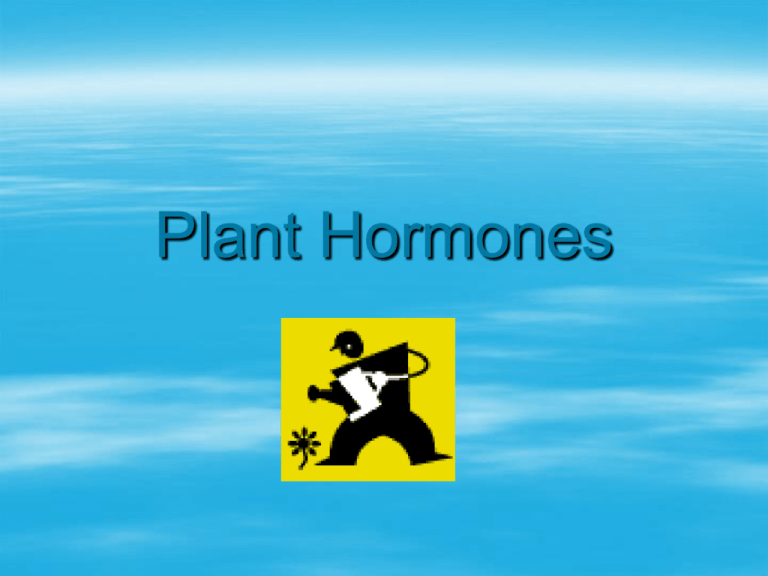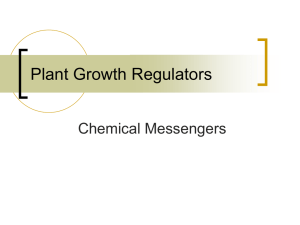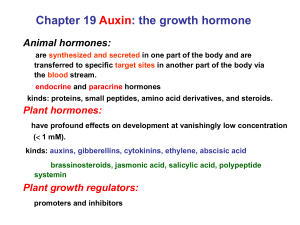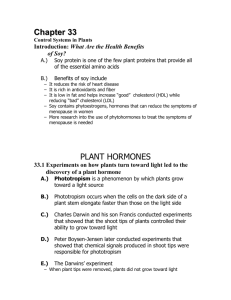Plant Hormones
advertisement

Plant Hormones Types of hormones Like animals, plants use hormones to produce functional and structural changes. Types of hormones include Auxins Gibberellins Cytokinins Ethylene Auxin Auxins are a type of hormone that produces cell elongation and allows the plant to grow in length and to develop. The natural Auxin is a compound called indoleacetic acid or IAA Auxin Auxin associated with phototropism - early experiments demonstrate tip as receptor. Auxin continued Auxin is made at the apical meristem of a shoot and moves down at a rate of 10 mm per hour to the region of elongation and stimulates cell growth. Question???? At this speed, how do you think it is transported through the cell? Auxin moves down the plant Answer Too slow for phloem transportation It is carried by the parenchyma tissue from one cell to the next. Auxins do two things to help with cell elongation: 1. Soften the cell walls so the plant can expand 2. Increase the rate of cell division Demonstration of transported chemical Loosening of cell wall Lateral growth Auxins produced in the meristem inhibits growth of side branches (lateral stems) Cytokinins Cytokinins You will remember from Mor 4 that cytology is the study of cells. The hormone, Cytokinins stimulate cell division (mitosis and cytokinesis) Cytokinins are produced by actively growing tissue and can move throughout the plant in the xylem, phloem and parenchyma cells. Function of cytokinins Promotes cell division. Lateral bud development. Delay of senescence (AGING). Stomata opening. Rapid transport in xylem stream. Cytokinins are used with Auxins to help plants to grow and develop Gibberellin Effects of Gibberellins General cell elongation. Breaking of dormancy. Promotion of flowering. Gibberellins Gibberellins are growth hormones that allow the plant to grow in length. Gibberellins were discover in Asia when some farmers noticed that rice would grow too fast and tall which was caused by a fungus called Gibberella. Gibberellins are usually produced in roots and young leaves and stimulate a growth in leaves and stems but not in roots. Gibberellins are also found to increase seed germination and flower development Discovered in association with Foolish disease of rice (Gibberella fujikuroi) uninfected infected Gibberellins and plant growth Ethylene H H \ / C = C / \ H H Functions of ethylene Gaseous in form. Rapid diffusion. Affects adjacent individuals. Senescence (aging) and abscission (the natural process by which leaves or other parts are shed from a plant). Interference with auxin transport. Initiation of stem elongation and bud development. Ethylene gas Years ago, farmers use to heat fruit in a kerosene oven to make them ripen faster. Scientist learnt that it was not the heat but the ethylene gas byproduct that made it ripen We now know that plants develop their own ethylene as a hormone that makes fruit ripen Ethylene Scientist also discovered that ethylene is the opposite to Auxin and inhibits cell growth Thanks Class Have a great day!!!











